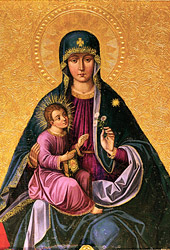Trakai Mother Of God Image
The painting of the Mother of God and Child, which for centuries has brought renown to the Trakai church, is closely linked with the name of Lithuanian Grand Duke Vytautas. An early 18th century inscription on the back of the painting states that it was given as a gift to Vytautas on the occasion of his Baptism by the Byzantine Emperor Manuel II Paleologo (1350–1425). The inscription also states that this is the icon Nikopoia (Greek for ‘She who brings Victory’), which helped Emperor John Komnenos (1087–1143) break through the Persian siege and successfully return to Constantinople. There is little historical evidence regarding Vytautas’s role in the acquisition of the very old image of Mary. However, the legend of the painting’s origin is based on reliable testimonies that for six centuries the image has been an object of devotion not only for Catholics and Orthodox, but also for local Muslims in the service of Vytautas. What above all links the 15th-century Trakai Madonna with the icon that the Byzantine emperor considered the Protectress of his person and his throne is the historical meaning: testament to the faithfulness of a state and its ruler to Christ, and to the defence of the faith.
Investigations during restoration work on the painting showed that the oldest layer of paint contains a late gothic-style full-figure portrait of the Blessed Virgin, portrayed with her hair uncovered except for a transparent veil and perhaps wearing a crown of roses. At the start of the 17th century, the painting seemed disproportionately large for a new central altar that was being installed, and so it was trimmed. The background was engraved and gilded anew, and the figure of Mary was repainted with Byzantine characteristics: the head and brow of the Mother of God were now covered not with a veil, but with the heavy folds of the figure’s cape.
The image, as seen by pilgrims today, shows the Mother of God in the Hodegetria icon style. She is seated and looking towards the viewer; the Child Jesus sits on her left knee wearing a purple tunic, holding a book in his left hand and reaching out with his right hand to three roses with three blossoms each, which his Mother holds and which symbolize the mysteries of the Rosary. A Greek cross is painted on the forehead area of the cape, and a star on the left shoulder. In Marian icons, stars on the forehead and shoulder indicate the Virgin’s chastity. The painting is characterized, on the one hand, by a Byzantine iconographic scheme that seems to set its figure apart from earthly reality. At the same time, it also shows traits of Western European painting of the late Middle Ages: in particular, broad clothing that conceals the figure under its folds, and an idealized face that recalls the 15th century images of Mary “all fair” (Tota Pulchra). The Trakai Mother of God thus reflects a unique combination of Byzantine, medieval and baroque styles.
The image of the Trakai Mother of God was adorned in September 1718 with crowns sent from Rome. That coronation ceremony is recalled today by a crown hanging over the main altar in the vault of the presbytery. The painting’s cover of gilded silver plate dates to 1723–1724.
Votive offerings testify to the extraordinary graces that people receive when praying before the image. They existed even before it was repainted in the early 17th century. At that time, votive offerings were generally attached near the painting with nails. Some 394 nail holes remain as evidence of the offerings. The oldest votive plaque is dated 1603. The votive offerings currently on display denote a number of cures, most of which occurred between the end of the 18th century and the middle of the 20th century.








